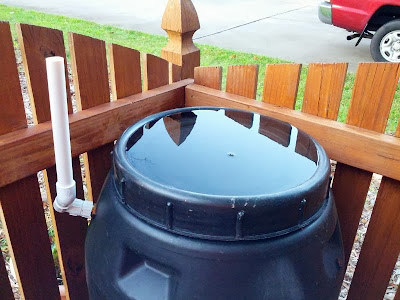I've spent a lot of time trying to come up with a solution to this problem. The best option I could think of is to fill the barrel from the top and empty it from the bottom like I did with the barrel under my deck.
This requires a float valve at the top to stop the flow of water when it's full, and a check valve at the bottom so water can flow out but not in.
The check valve I used previously was $15 (with shipping). I didn't want to spend that much again, so I had to come up with something else. That's when I found the following video on youtube.
Parts list:
- 3/4" PVC pipe
- Orbit 3/4 in. MNPT x 1/2 in. Barb Adapter
- Orbit 3/4 in. Slip x FHT PVC Fitting
- 3/4 in. Schedule 40 PVC Pressure Slip x FPT Adapter
- Nitrile Rubber Ball, 3/4" Diameter
- 1 1/4" finish nails
- Rubber O-ring
I started by cutting both ends off of one of the nails with a pair of wire cutters.
Then I drilled a 1/16" hole through the PVC pipe and inserted the nail.

Then I placed a rubber O-ring in the slip side of the slip x FHT PVC fitting. The rubber ball went in next. The pressure from the water will push the ball into the O-ring and plug the hole. This will prevent the flow of water in that direction. When the water pressure from the other side is higher, the ball will dislodge and be stopped by the nail. That creates enough room for the water to flow out.
The final step was to screw the barb into the fitting and glue the pieces together. |
| Water should only flow from the hose side to the barbed side. |
I verified that the water was able to flow in that direction.
Then I reversed the connections.
No water came out of the check valve. Success!
The next step was to attach this thing into my overflow rain barrel. I connected the irrigation tubing so that it'll fill the barrel from the top. (I still need to get a float valve so it shuts off when full.) Then I put the check valve on the outlet at the bottom and connected it to the tubing coming from my other barrels. That way they'll be able to draw from this barrel when they get low.
This barrel also feeds the overflow barrel by my shed. That barrel is much lower than this barrel, so I don't need to worry about putting a check valve on that side of the splitter. The water from that barrel won't run uphill and overflow this barrel.
The check valve caused some clearance issues. It was too close to the ground which caused a kink in the tubing. I remedied this by installing a 3/4" elbow between the PVC fitting and the barb adapter.
This setup seems to be working so far. The barrel isn't filling from the bottom and overflowing. I think I'll have a better idea of how well it works the next time we get more rain.











No comments:
Post a Comment